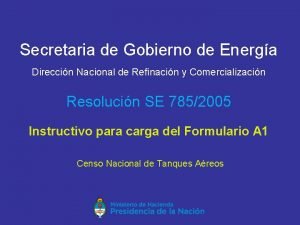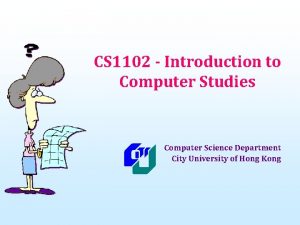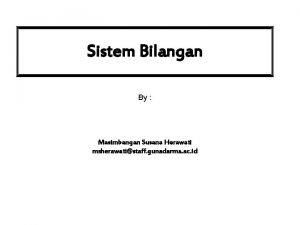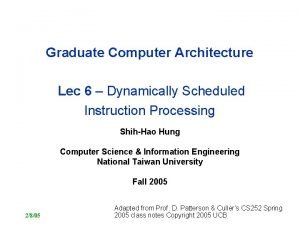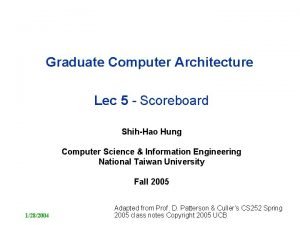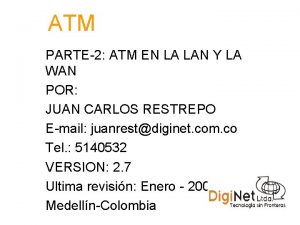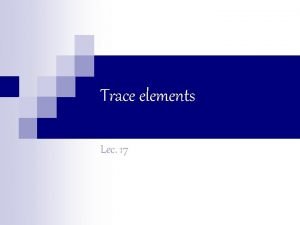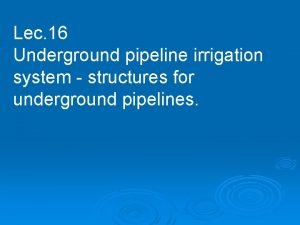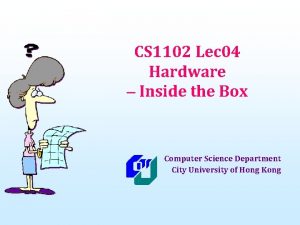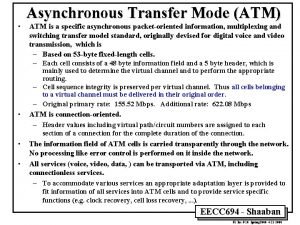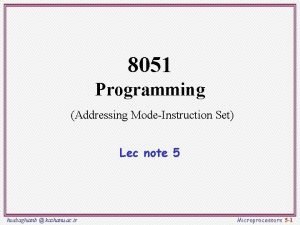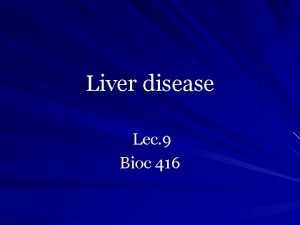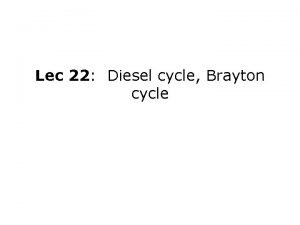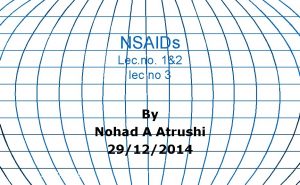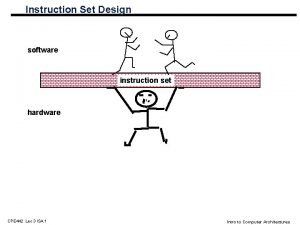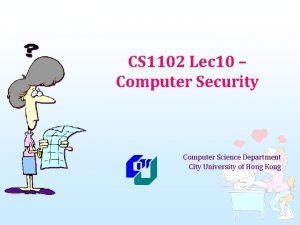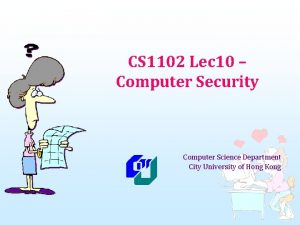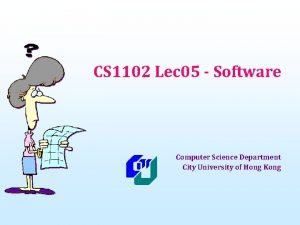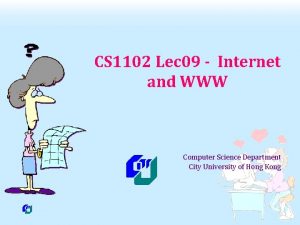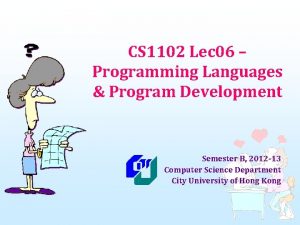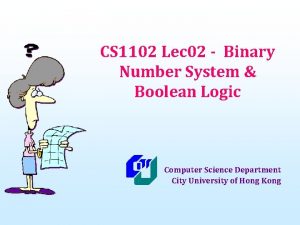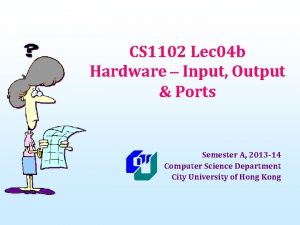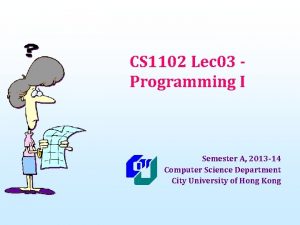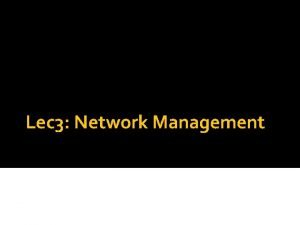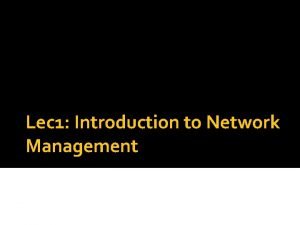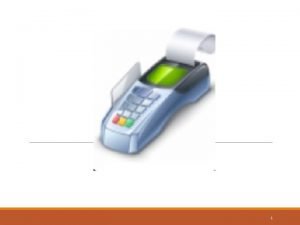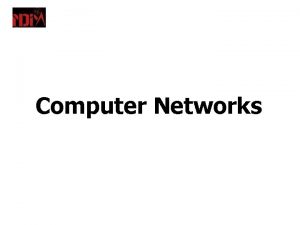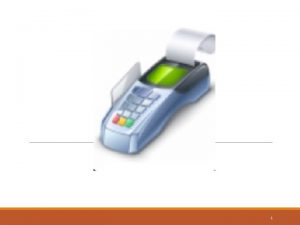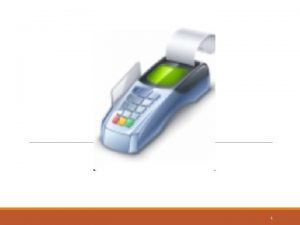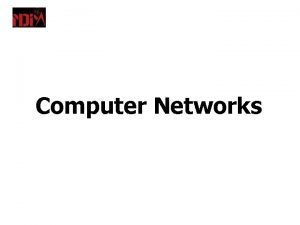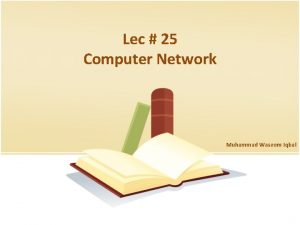CS 1102 Lec 08 Computer Network Computer Science

































![Reference [1] Copper and Glass: A Guide to Network Cables 8 http: //www. windowsnetworking. Reference [1] Copper and Glass: A Guide to Network Cables 8 http: //www. windowsnetworking.](https://slidetodoc.com/presentation_image_h2/656fd10ed19d841a4833cf8666318c94/image-34.jpg)

- Slides: 35

CS 1102 Lec 08 - Computer Network Computer Science Department City University of Hong Kong

Objectives : Illustrate advantages of using a computer network : Discuss the purpose of the components required for successful communications : Illustrate how a stack of network protocol layers work together : Identify commonly used data transmission medium and communication devices : Differentiate between client-server and peer-to-peer networks : Name the most widely used LAN network communications standards : Draw a conceptual diagram illustrating the Internet backbone, NSP, ISP, and routers : List various options to access and connect to the Internet Jean Wang / CS 1102 – Lec 08 2

Networks and Communications : Computer network - a group of computers connected together to communicate, exchange data, and share resources in real time 8 Computer communications - the process in which two or more computers or devices transfer data or instructions by way of a medium Jean Wang / CS 1102 – Lec 08 3

Network Enables… : Simultaneous access to data : Personal communication 8 Data files are shared 8 Email 8 Instant messaging 8 Conferencing 7 Data are stored in a centralized place 7 All users have access to identical, up-todate information 8 Software can also be shared 7 Site licenses : Sharing of hardware resources 7 Videoconferencing 8 Voice over IP 7 Phone communication over network wires 8 Printers and faxes are commonly shared : Easier data backup devices 8 Usually in business corporations 8 Reduces the cost per user 7 Employers keep the data on a shared : Collaborative work by multiple people Jean Wang / CS 1102 – Lec 08 storage device 7 The network manager makes regular backups of the data 4

Components in Communications : Components in a communication system 8 Sending device/computer 7 The device/computer initiates instructions to transmit information 8 Communication device on the sending side 7 The device converts the information from the sending device into signals carried by the communication channel 8 Communication channel 7 The media on which the information travels 8 Communication device on the receiving side 7 The device converts the signals from the communication channel to the data that the receiving device can recognize 8 Receiving device/computer 7 The device/computer accepts transmission of information Sending device Modem (network card) Jean Wang / CS 1102 – Lec 08 Physical medium Modem (network card) Receiving device 5

Network Protocol : All communication activities on a network are governed by protocols 8 An agreed-upon format or a set of rules for transmitting data between two devices 8 E. g. , a human protocol and a computer network protocol Hi Connection request Hi Connection response Got the time? GET www. google. com HTTP/1. 1 2: 00 Jean Wang / CS 1102 – Lec 08 <file> time 6

Protocol “Layers” GET a file SEND a file Assemble packets to file Divide data to packets Receive a packet in Net Route each packet in Net Receive packet on a link Transmit packet on a link Server side Client side : The job of data transmission in Internet is too complex. : It is divided into layers. : NOTE: internet is packet-switching network Physical Communication Link Jean Wang / CS 1102 – Lec 08 7

Layers of data transmission Data Transmission TCP IP IP Data link Data Link Physical signal transmission : Each layer independently provides a service 8 has a function separate from other layers 8 rely on services provided by layer below Jean Wang / CS 1102 – Lec 08 8

OSI 7 Layer Model of Computer Networks Applications TCP IP Ether. Net Modem Jean Wang / CS 1102 – Lec 08 9

Network Protocol Stack : The network is divided into layers, each of which has a function separate from that of the other layers Ø OSI Network Model Layers Examples 7) Application HTTP, FTP, Telnet 6) Presentation ASCII 5) Session SSL 4) Transport TCP, UDP 3) Network IP, IPX 2) Data Link Ethernet, Token Ring, 1) Physical IEEE 802. 11, IEEE 802. 16, ISDN : The protocol stack or protocol suite is the vertical arrangement of the layers; each layer is governed by its own set of protocols Jean Wang / CS 1102 – Lec 08 10

Example of How Network Protocols Work Together Jean Wang / CS 1102 – Lec 08 11

Communication Channel : Communication channel - the transmission media that are capable of carrying signals 8 Analog signal : continuous 8 Digital signal: discrete (either high or low) 7 The speed at which signal can change from high to low is called signal frequency 8 Bandwidth is the amount of data that can transmit over the channel (data transfer rate) per unit of time 7 Usually measured in Kbps, Mbps or Gbps (bits per second) þ Low bandwidth is 56 Kbps þ High bandwidth is over 1. 5 Mbps (also called broadband) 8 Latency is the time it takes a signal to travel from one place to another 8 Transmission media can be wired or wireless: Wired (with cables) Wireless Twisted-pair cables Infrared rays Coaxial cables Radio waves Fiber optic cables Microwaves Jean Wang / CS 1102 – Lec 08 12

Cable Transmission Media : Twisted-pair cable 8 Most common LAN cables (similar to telephone lines) 8 Consisting of pairs of twisted copper wires - twisted to prevent wires from electromagnetic interference 8 Transfer rate up to 100 Mbps ~ 1 Gbps : Coaxial cable 8 Similar to wires used for cable TV 8 Can be laid underground or underwater for both short (in office) or long distance 8 Transfer rate up to 1 Gbps ~10 Gbps : Fiber-optic cable 8 Bundles of hair-thin strands of glass that uses light beams to transmit signals 8 Faster than coaxial and twisted-pair 8 Transfer rate approaching 100 Gbps 13 Details in reference [1]

Wireless Transmission Media : Infrared Ray (IR) 8 8 Signals carried in infrared light waves Travel in straight line with no obstructions Transmission distance up to 30 meters Transfer rate up to 4 Mbps : Radio Frequency 8 Signals carried in electromagnetic waves 8 Signals broadcast in omni-directions (can reflect back & forth on obstacles) 8 Bluetooth 7 Transmission distance up to 10 meters 7 Transfer rate up to 2 Mbps 8 Cellular phone radio 7 Transmission distance up to 10 kilometers 7 Transfer rate up to 15 Mbps (4 G) 8 Wi. Fi 7 Transmission distance up to 180 meters outdoor 7 Transfer rate up to 108 Mbps Jean Wang / CS 1102 – Lec 08 14

Wireless Transmission Media : Micro Waves 8 Signals carried in high frequency electromagnetic waves 8 Signals broadcast in omni-directions 8 As the earth is round, we need many microwave stations to relay data over a long distance 7 The earth-based reflective dishes are built at a distance of around every 30 miles (48 kilometers) 8 Communication satellite 7 Space station that receives microwave signals from earth-based stations, amplifies the signals, and broadcasts them back to other stations on earth Jean Wang / CS 1102 – Lec 08 15

Transmission Rates Jean Wang / CS 1102 – Lec 08 16

Network Card Network card (called Network Interface Card, NIC) : Adapter card or PC card that enables computer or device to access network : Each card has a unique address MAC (Media Access Control) address: used to identify the computer in networks : E. g. Ether. Net card address is a typical example of MAC address. It is a 48 -bits address in the format of: 0 e: 3 c: 24: 3 a: 03: 06 IEEE allocates Ether. Net addresses to all manufacturers to ensure the uniqueness of addresses Jean Wang / CS 1102 – Lec 08 17

Communication Devices 8 Wireless access point 7 Devices that transports data wirelessly to a wired network 8 Router 7 Devices that connect computers or other routers to route data to their correct destinations in the network 7 For smaller business and home networks, a router (or called switch or hub) allows multiple computers to share a single high-speed Internet connection through a cable modem or DSL modem 7 Many are protected by a hardware firewall Jean Wang / CS 1102 – Lec 08 18

Types of Computer Networks : Common types of networks 8 LAN (local area network) 7 Networks that are in local geographical areas, such as homes or office buildings 7 connected using cables or wireless media 7 E. g. , home network, CS department network in City. U 8 WAN (wide area network) 7 Networks that cover a wide geographic area 7 Using long distance transmission media to link computers separated by a few or thousands of miles 7 Internet is the world's largest WAN Jean Wang / CS 1102 – Lec 08 19

How Networks Are Architected/Structured : Client-server network 8 Individual computers (called client) are connected to a central computer (called server) 8 Clients request for services whereas servers provide services 8 The clients can access programs or files stored on the server 7 E. g. , application server, file server, print server 8 Server and client computers install different software 7 Domain name server (DNS) 7 File server 7 FTP server 7 Web server 7 Email server 7 Print server 7 Database server 7 Network server Jean Wang / CS 1102 – Lec 08 20

How Networks Are Architected/Structured : Peer-to-peer networks (P 2 P) 8 Every computer, called peer, is connected directly or indirectly to other peers 8 Each computer provides its own resources to other computers, and in the mean time can access resources of other computers 8 All computers need to run the same P 2 P software (protocol). E. g. , Bit. Torrent is one of the most commonly used P 2 P protocols Jean Wang / CS 1102 – Lec 08 21 Details in reference [5]

Network Classification Summary CATEGORY DESCRIPTION EXAMPLES Geographical Area where network devices are located LAN, WAN Structural Hierarchy of devices Client/Server, P 2 P Transmission Media Technologies for cables twisted-pair, coaxial, or fiber and signals that carry data -optic cable; radio frequency; microwaves; infrared Bandwidth Capacity of network Jean Wang / CS 1102 – Lec 08 Broadband, narrowband 22

What is the Internet? : The Internet is an interconnected network of thousands of local, regional, national and international networks : Connects computers to almost every country in the world 8 Growing too fast to measure its growth 8 Too decentralized to quantify 8 A network with no hard boundaries Jean Wang / CS 1102 - Lec 09 23

Internet Infrastructure : Internet has the Internet backbone to interconnect all regional networks 8 The Internet backbone consists of high-speed fiber-optic links connecting high-capacity routers or communication satellites 8 Constructed and maintained by NSP (Network Service Providers), usually major telecommunication companies or governments : Besides the backbone, the Internet also contains regional and local communication links such as local telephone systems, cable television lines, mobile phone systems, and satellite dishes 8 Constructed and maintained by ISP (Internet Service Providers), usually regional or local telecommunication companies or cable television companies Jean Wang / CS 1102 - Lec 09 24

Internet Infrastructure : Large ISPs connect directly to NSP backbone routers to gain backbone access : Smaller ISPs typically connect to a larger ISP routers to gain Internet access : End users connect their computers to ISP cables to gain Internet access home Jean Wang / CS 1102 - Lec 09 25

How your request is sent over the Internet home ISP NSP home Jean Wang / CS 1102 - Lec 09 : Step 1 - your computer requests information through either wired or wireless connection to the ISP : Step 2 - when the request leaves the ISP, it travels over T 1 lines, and possibly microwave stations, earth-based stations, and communication satellites, until it reaches the Internet backbone provided by the NSP : Step 3 - the request travels over dedicated high-speed lines along the Internet backbone (T 3 lines) : Step 4 - the request reaches the ISP of the destination network server : Step 5 - from the ISP, the request then travels over telephone lines or other transmission media until it reaches the destination network server 26

Internet Access Options : Dial-up connections 8 Use standard telephone lines + a modem 8 Bandwidth is up to 56 Kbps 8 Converts signals between analog and digital : ISDN and DSL connections 8 Use standard telephone lines + ISDN/DSL modem + a NIC card 8 ISDN bandwidth is up to 128 Kbps 8 DSL bandwidth is up to 1. 5 Mbps : Cable connections 8 Available from telephone companies, cable TV services, networking companies, or satellite service providers 8 Coaxial cable line + a cable modem + a NIC card 8 Bandwidth is up to 1. 5 Mbps : Others include: cellular services, satellite connection services Jean Wang / CS 1102 - Lec 09 27

Dial-up Connections : A dial-up connection is a fixed Internet connection that uses a voice-band modem and telephone lines to transport data between your computer and your ISP 8 A voice-band modem converts the digital signals from your computer into analog signals that can travel over telephone lines Jean Wang / CS 1102 - Lec 09 28

ISDN or DSL : High-speed, digital, always-on Internet access technology that runs over standard phone lines Since all voice conversations take place below 4 KHz, the low-pass (LP) filters are built to block everything above 4 KHz, preventing the data signals from interfering with standard telephone calls. Jean Wang / CS 1102 - Lec 09 29

Cable Internet Service : Cable Internet service distributes broadband Internet access over the same infrastructure that offers cable television service ² The coaxial cable used to carry cable television carry hundreds of mega-hertz of signals ² The cable modem takes up some of the un-used frequency bands to transmit Internet upstream and downstream data Jean Wang / CS 1102 - Lec 09 30

Fixed Internet Connection Roundup Jean Wang / CS 1102 - Lec 09 31

Lesson Summary : A computer network is a system of connected computers that can exchange information and share resources : The advantage of a network include: better communication, data and resource sharing, efficient backup : The separation of a network design into layers allows for modular design, and divides the responsibility of the different layers; within each layer, protocols are defined as the rules governing the format, speed, initiation and synchronization of communication. : Networks can be distinguished by the distances they cover. LAN locates within a relatively limited area. WAN spans a wide geographical area. : Two common network architecture include: client-server model and peer-to-peer model Jean Wang / CS 1102 – Lec 08 32

Lesson Summary (continued) : Common communication channel or transmission media include: twisted-pair cables, coaxial cables, optical fiber cables, infrared rays, radio, microwaves : Communication devices include: modem (dial-up and cable), network card, wireless access point, hub, and router : You can connect to the Internet in several ways using different communication devices Jean Wang / CS 1102 – Lec 08 33
![Reference 1 Copper and Glass A Guide to Network Cables 8 http www windowsnetworking Reference [1] Copper and Glass: A Guide to Network Cables 8 http: //www. windowsnetworking.](https://slidetodoc.com/presentation_image_h2/656fd10ed19d841a4833cf8666318c94/image-34.jpg)
Reference [1] Copper and Glass: A Guide to Network Cables 8 http: //www. windowsnetworking. com/articles_tutorials/Copper-Glass-Guide. Network-Cables. html [2] How. Stuff. Works. com - Fiber Optics 8 http: //www. howstuffworks. com/fiber-optic. htm [3] Wikipedia – Radio Spectrum 8 http: //en. wikipedia. org/wiki/Radio_spectrum [4] Introduction to Wi. Fi Standards 8 http: //www. crutchfield. com/S 3 id. ETr 5 R 3 y. J/learningcenter/home/wifi. html [5] The World of Peer-to-Peer (P 2 P) 8 http: //en. wikibooks. org/wiki/The_World_of_Peer-to-Peer_(P 2 P)/All_Chapters [6] Bluebooth 8 http: //www. makeuseof. com/tag/technology-explained-what-is-bluetooth/ [7] How. Stuff. Works. com - Router 8 http: //computer. howstuffworks. com/router. htm Jean Wang / CS 1102 – Lec 08 34

For you to explore after class Ø Lec 08 -Q 1: Could this network (with one central server in the middle) be used for peer-to-peer communication and explain your reason? Ø Lec 08 -Q 2: say your Internet connection's bandwidth is 1 Mbps, how many seconds you need to download from the Internet a 4 -minute MP 3 song with 128 Kbs? (assuming 1 Kb=103 bits and 1 Mb=106 bits) Ø Lec 08 -Q 3: say you want to watch a real-time streaming video of Formula 1 Race, and this video's frame size is 320 x 240, frame rate is 30 fps, color depth is 24 -bit, video codec compression ratio is 1: 60, and audio bit-rate is 64 Kbps mono, what is the minimum bandwidth you needs in order to smoothly watch this video? Jean Wang / CS 1102 – Lec 08 35
 Web res. 1102-404 y res. 785
Web res. 1102-404 y res. 785 Comp sci 1102
Comp sci 1102 Chemsheets amino acids
Chemsheets amino acids Phil 1102
Phil 1102 Penjumlahan biner 1012+1102=........2
Penjumlahan biner 1012+1102=........2 What is his favorite subject?
What is his favorite subject? Scoreboard architecture
Scoreboard architecture 11th chemistry thermodynamics lec 13
11th chemistry thermodynamics lec 13 Lec ditto
Lec ditto Lec scoreboard
Lec scoreboard Componentes del lec
Componentes del lec 11th chemistry thermodynamics lec 10
11th chemistry thermodynamics lec 10 Lec elements
Lec elements August lec 250
August lec 250 Lec 16
Lec 16 Lec material
Lec material Apelacin
Apelacin Lec
Lec 132000 lec
132000 lec Xrl instruction in 8051
Xrl instruction in 8051 Tura analítica
Tura analítica Sekisui s-lec america llc
Sekisui s-lec america llc 416 lec
416 lec Lec
Lec Diesel lec
Diesel lec Lec promotion
Lec promotion Lec anatomia
Lec anatomia History of software development life cycle
History of software development life cycle Fenemates
Fenemates Lecsl
Lecsl Lec hardver
Lec hardver Lec renal
Lec renal 252 lec
252 lec What is topology in computer
What is topology in computer Datagram network
Datagram network Features of peer to peer network and client server network
Features of peer to peer network and client server network
